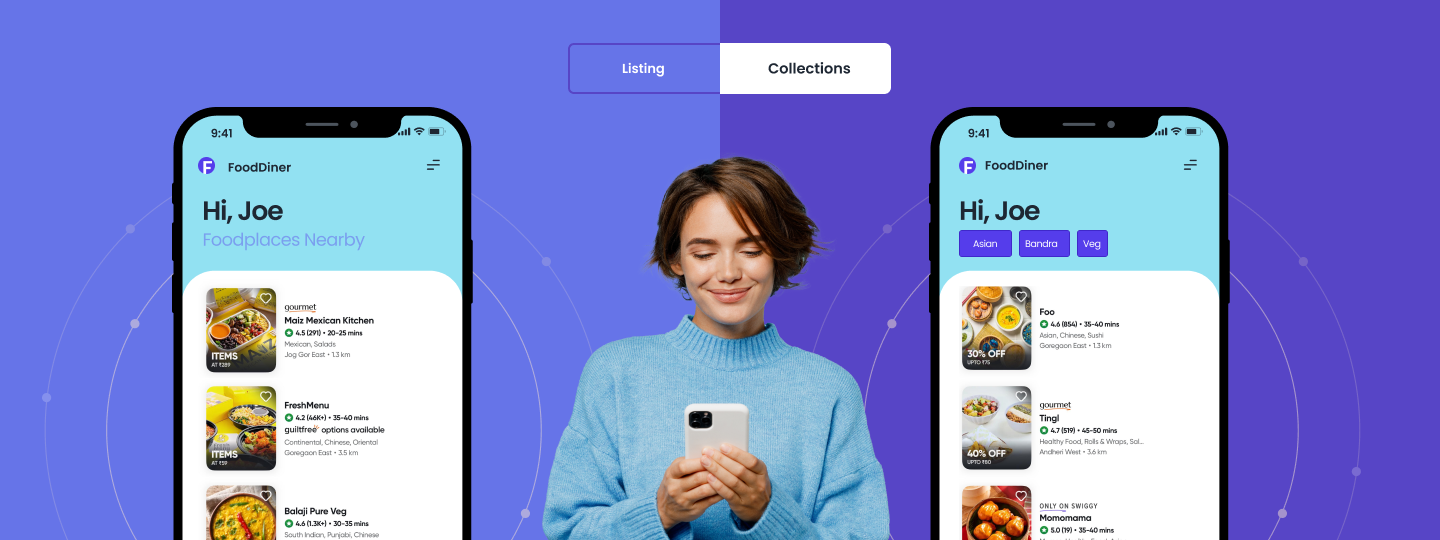What Are Push Notifications?
Push notifications are on-screen clickable alerts delivered by an app or website to users on their desktops, laptops, or mobiles. They contain snippets of information meant to be sent by brands to a user’s device.
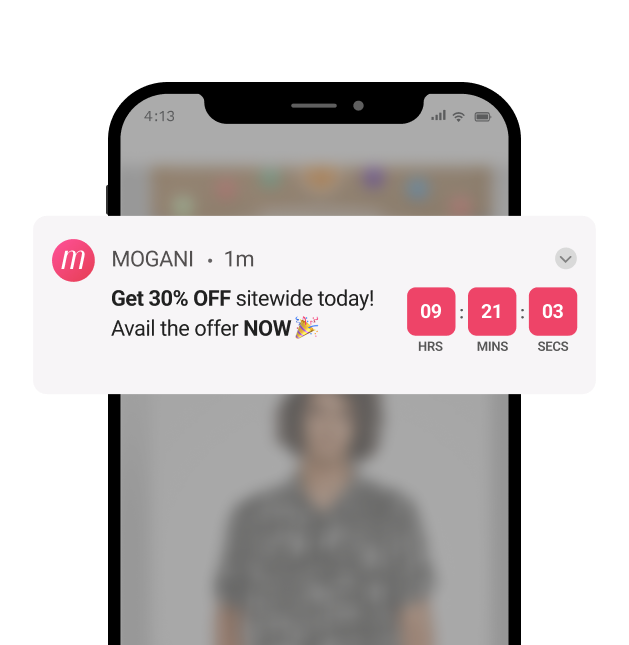
We all knew what notifications were but do we know why they’re called Push?
They are called push notifications because the publisher, not the user, initiates the updates. Push notifications allow businesses to interact with users after downloading the app or visiting a website.
Download Impact Story- Get Inspired By How Zivame Used Push Notification To Boost Conversions by a whopping 20%
Push vs. Pull
At the dawn of digital creation, there were two entities – clients and servers. Clients are receivers, while Servers are givers.
When a user visits a website and watches a video, what they (the client) are technically doing is requesting the website (the server) for information (the video).
Upon making this information request, the website shows the requested video. In other words, one could say they ‘pulled’ information from the website.
Let’s flip this example and look at it from another angle.
The same site releases a new video and sends the user a pop-up that reads – “Your much-awaited TV show just dropped its second season. Watch it”.
Unlike in the previous example, here, the website sent the user a piece of information without a request from them, OR it ‘pushed’ information to the user.
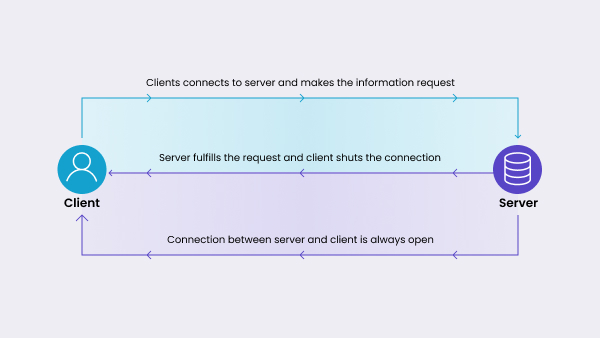
This is the fundamental difference between Push vs. Pull.
Having said that, a really great push notification can really pull you in.
How do Push Notifications work?
With a fair understanding of push notifications, it’s time to see them in action. For starters, let’s learn about
The five moving parts:
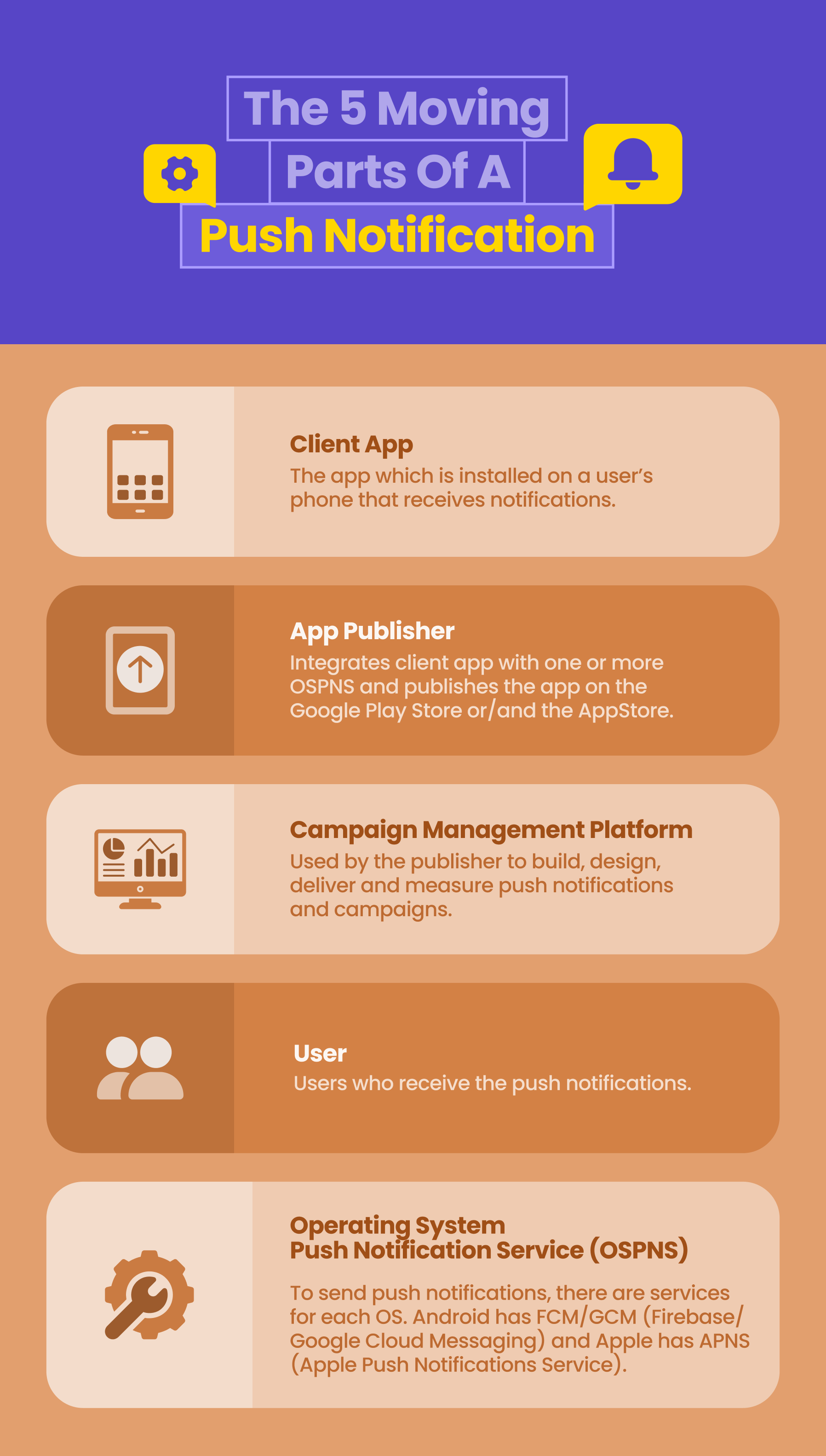
Lifecycle of a push notification
That being said, let’s see how these moving parts come together to create some effective push notification campaigns.
Publication of the app
- The app publisher integrates with the OSPNS.
- The app publisher receives an application programming interface (API) from the OS service. The app uses the API to talk to the service.
- The app publisher implants a software development kit (SDK) in the client app. The SDK is a code library native to the OSPNS.
- The app publisher publishes the app on the Google Play Store or/and the AppStore.
Installation of the app
- User downloads the client app from an app store.
- When a user opens the app, unique identifiers for both the device and the app are tagged to the OSPNS.
- The OSPNS passes these unique identifiers to the client app that sends them to the app publisher.
- The app publisher receives and stores these IDs along with other registration details.
Transmission of the notification
- The app publisher uses a campaign management platform to craft a message and uses the API to create an automated message to be sent via the API.
- The publisher then uses the platform to define a target audience of users who will receive effective push notification campaigns.
- The publisher decides if the notification should be sent now or scheduled for later.
Take a demo with WebEngage and create that ‘Aha’ experience for your customers with effective push notification campaigns.
Effective Strategies for Mobile Push Notifications: What Works?
To enhance mobile push notification effectiveness, consider these strategies:
- Ask for permission at the right time to increase opt-ins.
- Personalize notifications based on user behavior and preferences.
- Optimize for different platforms, ensuring a consistent user experience.
- Consider device limitations for smooth delivery and engagement.
How are Push Notifications Different from SMS and Email as Engagement Channels?
While there’s no shortage of communication channels today, ranging from the traditional ones like SMS & emails to the more new-age ones like Push & In-app notifications, many marketers still pin a huge chunk of their hopes on the former two.
And it’s surprising, to say the least!
You already know about the worldwide uprising against people checking their SMSs – people just don’t open their messages these days. And let’s not even talk about emails’ open rates and click-through rates (CTR).
Then there are other challenges with these platforms. For example, SMSs are subject to content whitelisting. As far as emails go, there’s no guarantee when your recipients would open them (if at all they do), which defeats the purpose of timely & prompt communication.
Now, I’m not downplaying the efficacy of mailers. It’s a hugely important engagement channel, but the problem surfaces when marketers limit themselves to emails. Today, a lot depends on what you want to communicate & not so much on how you want to communicate it. This is why there’s a dire need to look beyond traditional communication.
The alternative? – Push Notifications.
Push notifications solve can all of these. From a breadth of use cases to multiple customization options, push notification user engagement is are slowly becoming the gold standard for reaching out to customers. The idea that you can get your messages right in front of your users at just the right time (without asking them to move anywhere) with minimal effort & can customize your messages to invoke actions from them has paid attractive dividends.
And rightly so! Businesses use push notification for user engagement because they have a deliverability rate of 90%. They also increase their conversion rate by as much as 7X as opposed to email marketing.
As a channel that is not only accessible but also can actively engage your users, leading to higher conversions, it’s an option you just can’t ignore as a marketer.
Pro Tip: To sum up, push notification user engagement is different from SMS & Email in the following respects:
- Extremely prompt
- Very high deliverability, open & click rates
- Deep linking to specific pages
- Ability to use rich media
- Easy Opt-in process without the need for any personal info
- Cross-platform delivery
- Comparatively less costly, or in most cases free
- No cap / extra charge for the number of notifications you can send
To see how brands leverage push notification user engagement, read the case study on ALTBalaji, a Subscription-based Video-On-Demand (SVOD) platform.
How to enhance user engagement with push notifications?
Enhance user engagement with push notifications by:
- Segmenting and targeting to deliver personalized messages.
- Use rich media for visually appealing content.
- Testing CTAs and messages for effectiveness.
- Sending app update alerts to keep users informed.
- Optimizing notification size for better user experience.
- Timing notifications strategically for maximum impact.
Why Should You Use Push Notifications?
There was a time when marketing was mostly, if not all, about acquiring users. Businesses put zero to negligible efforts into retaining users, building user loyalty, ensuring repeat purchases, or establishing user advocacy.
Thankfully, that has changed!
Marketers increasingly realize the importance of retention marketing as a real business case. And today, there’s an equal, if not more, emphasis on retaining users through various methods of user engagement & remarketing.
But while there are multiple acquisition avenues, the engagement channels are reasonably limited. You can keep going back to your SMSs & emails, but when you have an audience who doesn’t like to open messages & keeps unsubscribing from emails, there’s really not much you can do in terms of engagement.
Enter Push Notifications.
And all of a sudden, you’re in a position to send rich media in your messages, ensure higher click-through rates via personalized communications & nudge your users to take action at the right time for your desired events.
Bonus Read – Increase Your CTR By 40% Using Push Notifications
Following are a few of the most common ‘whys’ of Push Notifications:
1. The Right Kind of Users
There will be different stages in your Buyer’s Journey, and pretty obviously, not all of your customers will be in the same stage. This is why even your messaging cannot be the same for all. Imagine sending a “complete your purchase” message to someone who’s not even visited your product page!
Hence, it becomes imperative that you hyper-personalize your messages based on your users’ standing in their respective journeys.
Your ultimate goal is to push your users, stuck at different levels of your buyer’s journey, deeper down the funnel and enable them to complete your desired actions. And unless you do your targeting right, your objective could remain elusive.
2. The Right Kind of Messaging
Have you ever been to an art exhibition? If you’ve and didn’t understand the hype surrounding seemingly weird paintings, then you’re like me.
But we cannot just outright refute the credibility of these paintings. Art lovers and painting aficionados would be outraged.
The same logic applies to communications. You cannot know what messaging will resonate with which person; hence, it’s vital that you continually experiment with your messages & then pick the one that seems most appealing yet data-driven.
3. The Right Kind of Delivery Mechanism
You’re not the only one who wants to engage with your users, right? There are a plethora of other brands that want to grab your users’ attention.
Let’s say your email lands in your user’s inbox at 1 am. They’re fast asleep. Now, by the time they get up in the morning and check their mailbox, there are 10s of other emails which ultimately push your mailer further down the queue, reducing its chances of being opened. As a marketer, you’d certainly not want that. So what do you do?
With Push notifications, you can choose the precise time when you want your users to receive your messages, specify the DND (do-not-disturb) times for your users, and send your messages in their respective time zones.
Ensuring just the deliverability won’t cut it anymore. A far greater emphasis ought to be laid on contextual delivery.
4. The Right Kind of Engagement
Let’s say your target audience is millennials between the age of 18 – 25. You know, today, the attention span of millennials is at an all-time low. Many apps are competing for this age group’s attention, and everyone is doing their utmost to create relevant content & communicate in the best possible way.
But is that enough?
Push notifications come with an added layer of innovation wherein you can compose rich messages (images, banners, carousels, GIFs, even videos), providing a memorable experience for your users and doing more than “just communicating.”
When top brands such as USA Today say that they saw an 18% increase in monthly app open rates by including rich notifications, it’s no joke!
Imagine if you could send delightful communications to your users right at the time, impressing upon the value they stand to derive by being on your app. Similar to what this brand does for its customers.
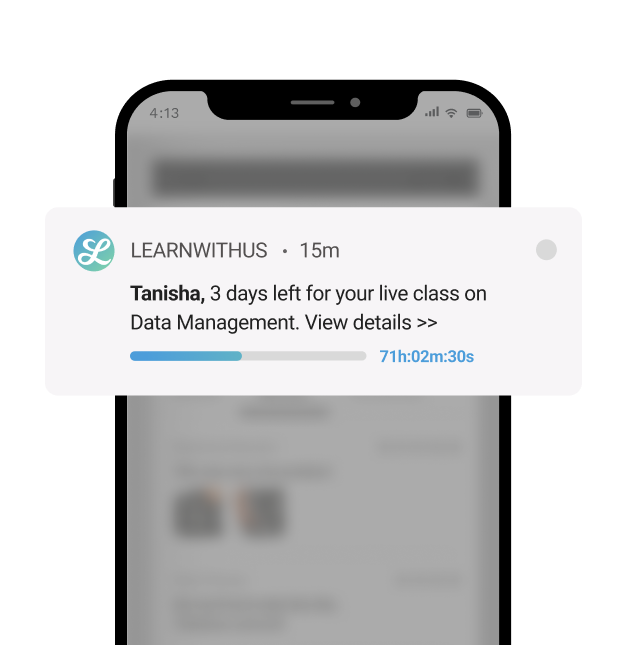
For an in-depth overview of how to maximize the value of your push notification campaigns, check out the Best Practices for Push Notifications.
Pro Tip: Your message strategy is more about the user than the brand. You are writing FOR THEM. NOT YOU.
Subscribe to our newsletter to stay updated on the latest in B2C marketing
What are the key elements of an effective push notification campaign?
An effective push notification campaign relies on key elements to maximize engagement, such as:
- Personalizing messages to individual preferences.
- Timing notifications for optimal user engagement.
- Crafting concise and compelling copy.
- Including clear calls-to-action for prompt user response.
Types of Push Notification Campaigns
In the era of Conversational Marketing, people are very mindful of what they receive. As such, as a brand, you need to be prudent about not just what you communicate but also when you communicate – the timing of your messages.
According to a survey by the UK’s Data & Marketing Association (DMA), 78% of respondents said they’d immediately delete the app or disable the notifications if they were unhappy with what they receive. And there could be many reasons for this unhappiness – irrelevant messages, untimely notifications, non-contextual notifications, etc.
Understanding your user behavior first could be the key to reducing your churn rate. So let’s have a look at some of the most common use cases for push notifications.
1. Triggered Campaigns
They are another very effective way to re-engage with your users. Like triggered email campaigns, triggered push campaigns are event-based campaigns sent to your customers once they complete a particular action.
Once inside your conversion funnel, your users receive a series of automated messages triggered by predefined rules, the aim of which is to move your users to the next funnel stage. You can send in multiple messages in a single campaign that a user will continue to receive until they complete your desired action & move to the next stage.
Defining the entry points (who receives what message) will be crucial here. While you want to convert your users stuck at different stages of your funnel, bombarding them with too many messages might prove counterproductive, leading to an increased churn rate.
Remember that there are users in your conversion funnel, ready to convert, all with just a nudge. And the best way to provide that nudge is through Triggered Push Campaigns.
2. Promotional Campaigns
Before I begin, let me debunk a myth for you.
According to this study, people like to receive promotional texts – as much as 57% of them. And this data is just about SMS, not considering the other communication channels.
Notifications that promote a product or service’s offerings to get users to take the desired action are called promotional notifications.
Suppose you’re an e-commerce company running a two-day sale on your app. How’d your consumers know about it? You don’t expect them to just be on your app at the right time, do you?
If your customers don’t know about such promotions, no matter how well-planned or thoughtfully targeted they are, they’re just not going to act like you want them to.
For all your new offerings, sales, giveaways, and exclusive offers, you’ve got to notify users and remind them (to create a sense of urgency & FOMO) to open your app at the right time to take the desired action.
When browsing your platform, your users give you a lot of behavioral data. This is called first-party data, which includes product preferences, purchasing power, browsing duration, etc. By leveraging this data, you can build immersive tailor-made promotional messages that resonate with your customers. Promotional messages could be about:
- Flash sales promotion,
- Brand news,
- Product launches,
- Newsletter updates,
- Affiliate/Referral programs.
3. Transactional Campaigns
There are notifications whose job is to deliver critical time-sensitive updates to the user. Such messages are called transactional notifications due to their transactional nature. They could be about:
- Order confirmation
- Payment success/failure
- Shipping status
- Return/Refund
- Billing update/upgrade/ downgrade
- Account update
- Signup Confirmation
- Account quota limit reached
But there’s a fine line between what your users want to be intimated about (what will excite them or if something is good enough to know) and what they might consider spamming. Just like any other campaign, your intimation campaigns must also have actionable components in the form Call-To-Actions (CTAs).
Pro Tip: Avoid sending the feel-good type of intimation campaigns unless your communication doesn’t concern a milestone (birthdays, anniversaries, or reaching a specific checkpoint).
Download eBook- A Marketer’s Guide to Mobile Push Notifications
Best Practices for Crafting Push Notifications?
Craft impactful push notifications with these best practices:
- Write concise and actionable messages
- Personalize content to resonate with users
- Segment your audience for targeted communication
- Experiment with emojis for added expression
- Using varied prompts to maintain user interest
Measuring Your Push Notification Campaigns
When measuring push notification campaign success, several push notification analytics and metrics matter:
- Open Rates
- Click-through/Open Rates
- Conversion Rates
- Time Spent Post-Click
- Influenced Conversions
- Enhanced Delivery Rate
What’s exciting about new-age marketing is that you can (and should) measure every campaign. Understanding the success of your initiatives, be it for acquisition or retention, is very important as the results will form the bedrock of your future campaigns, helping you better understand your target audience.
If you’re not measuring push notification analytics and metrics and not nurturing your consumer insights, there’s no way you can market or even sell your product effectively.
Let’s look at five key performance indicators (KPIs) in detail that will help you measure your push notification campaigns.
1. Opt-in Rates
Measure the number of users who have signed up to receive your push notifications.
2. Click-through/Open Rates
Measure the number of people who click on your push notifications.
3. Conversion Rates
Measure the number of people who complete a predefined goal after opening your push notifications.
4. Time spent on the app after clicking notifications/ Time spent on conversion.
Measures the time your users spend on your platform after clicking through a push notification.
5. Influenced Conversions
Measure the number of times your users manually open an app after receiving a push notification (rather than tapping on the notification directly to open the app) within a given time frame.
6. Enhanced Delivery Rate
Views and measures the click distribution on Chinese mobile manufacturers like Huawei and Xiaomi. WebEngage introduced Enhanced Delivery because the device-level restrictions in these devices kill background processes while stopping FCM (Google/Firebase Cloud Messaging) & APNS (Apple Push Notification Service) from delivering a push notification. Enhanced Delivery expands the current push notification delivery mechanism beyond FCM and APNs.
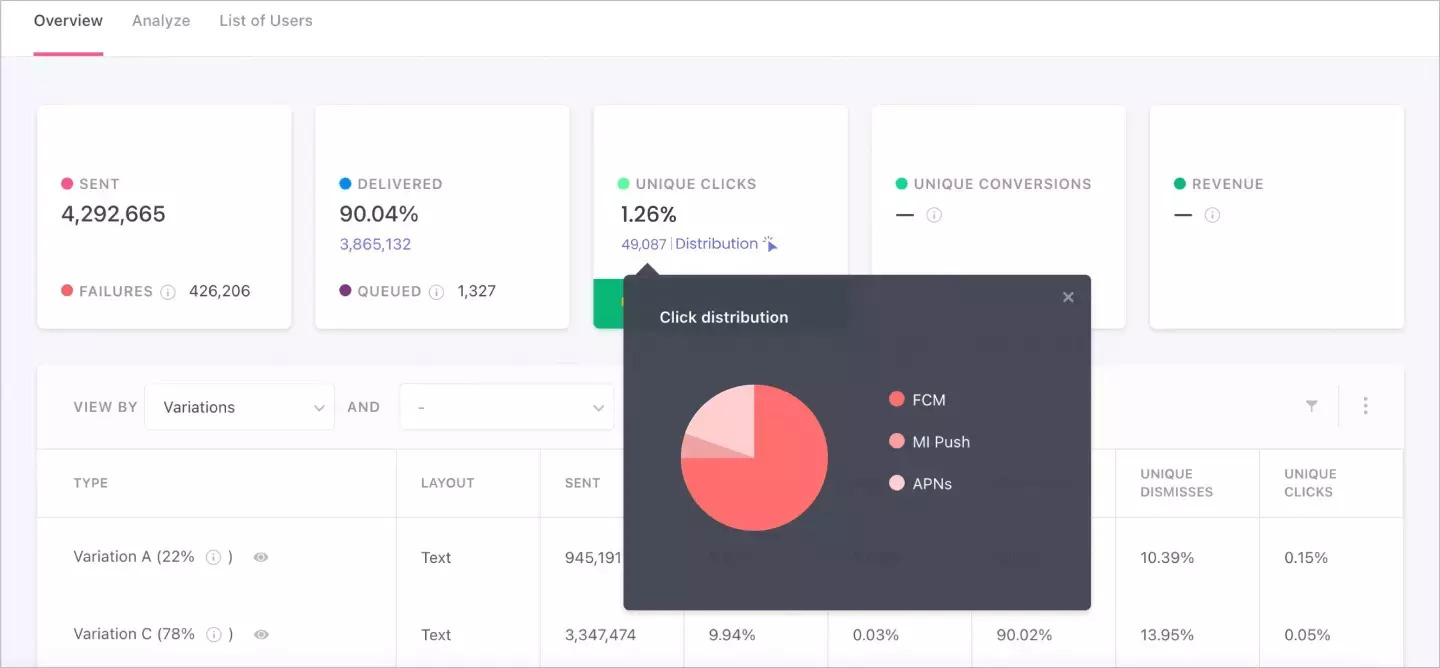
Push Notification Performance Stats
Due to the ubiquity of mobile devices, push notification have worked extensively well for mobile publishers. That’s the reason why it was introduced for the web as well. A whole industry has established itself on the back of this simple messaging medium.
To give you an overview of the performance of this medium, we have curated some key stats from reliable first-party and third-party sources.
First-Party Stats
According to our study, out of the 2 Billion messages sent by enterprise businesses that use WebEngage in the last nine quarters, 87% of the traffic was via push notifications.
Besides B2B, push notifications have also emerged as a widely used channel in the consumer market. Here’s the overall channel bifurcation –
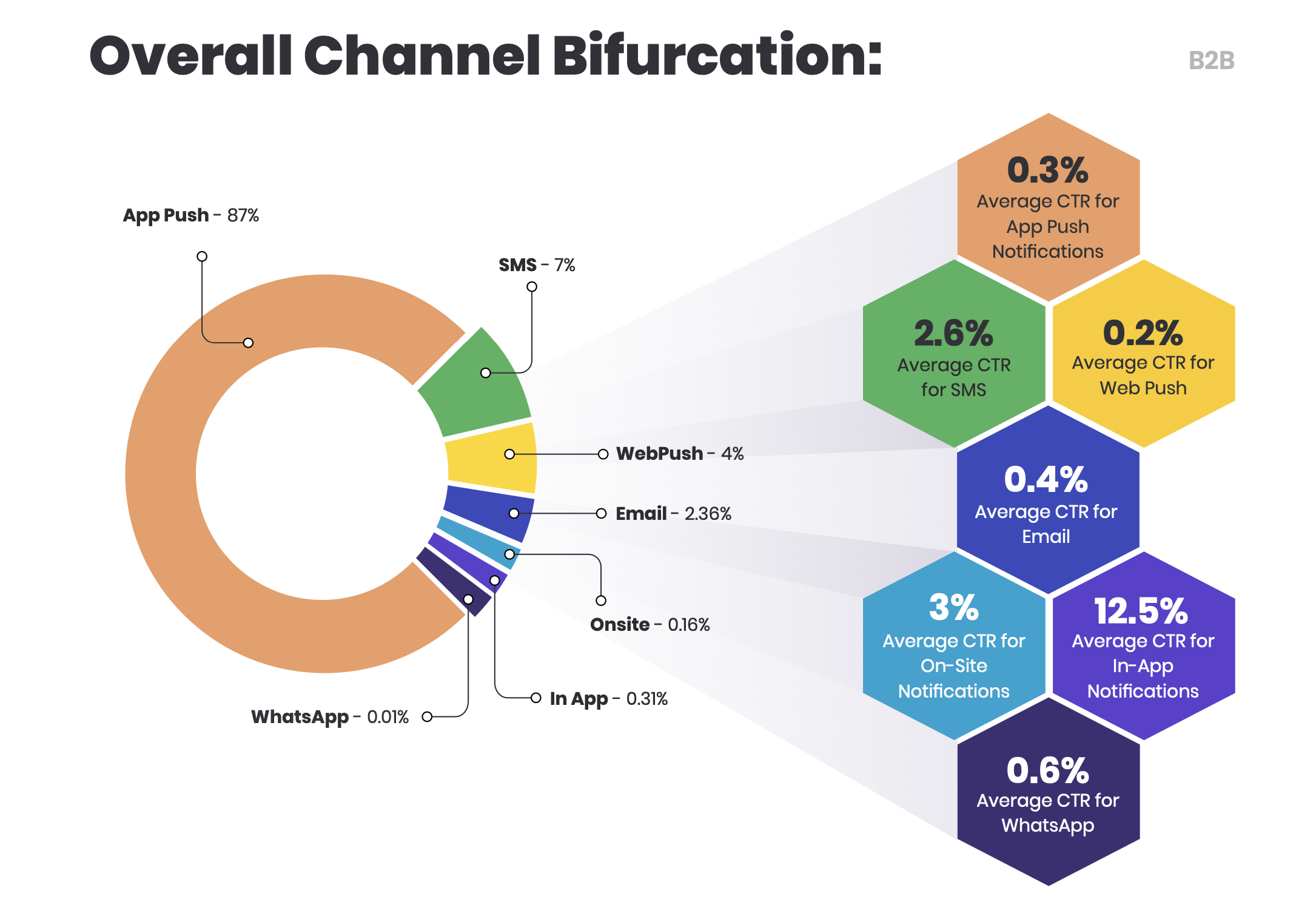
Source: WebEngage
Here’s how App Push Notifications perform as a channel.
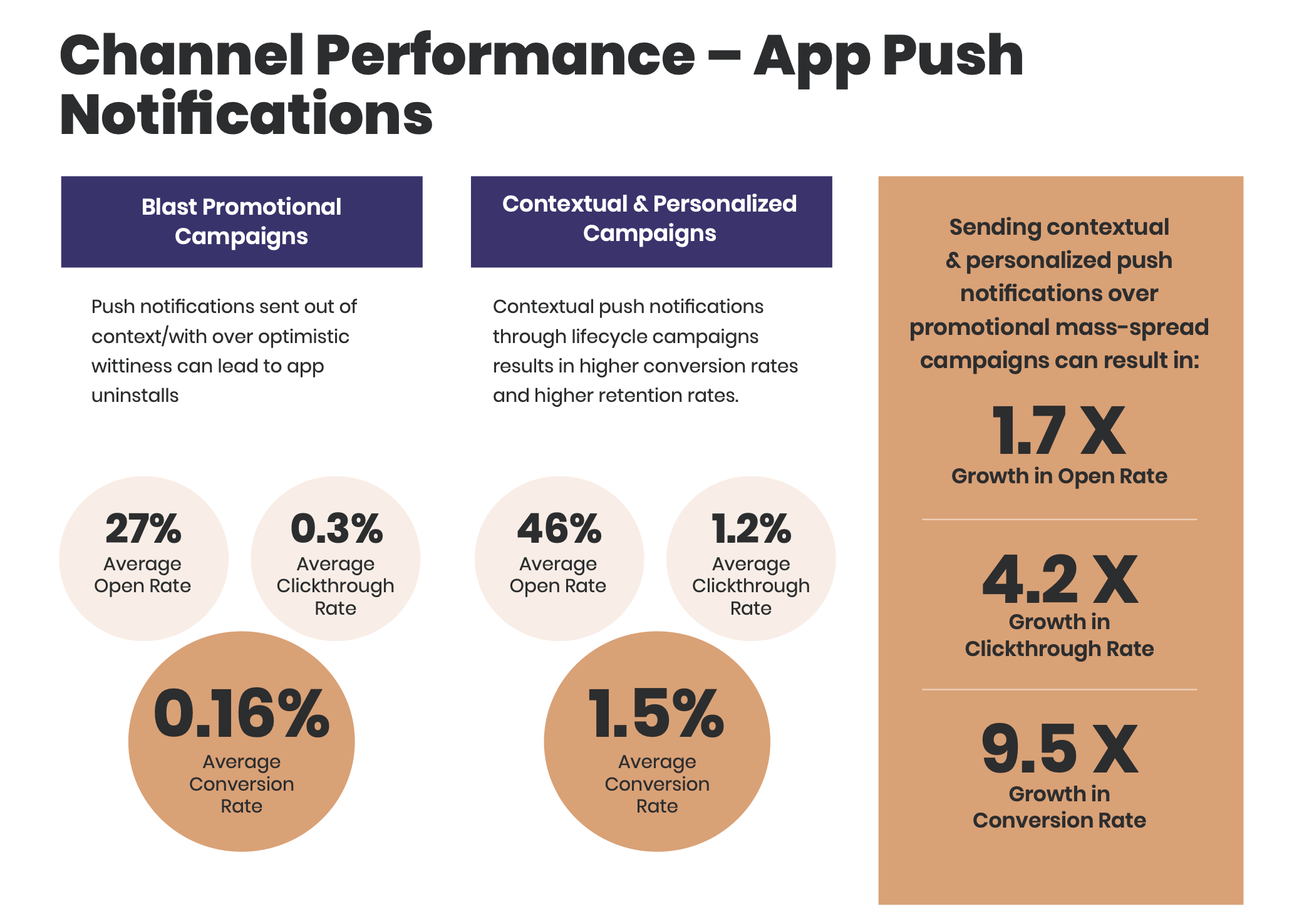
Source: WebEngage
Third-Party Stats (Source: businessofapps.com)
The average smartphone user receives 46 mobile push notifications per day
- Overall push notification opt-in rate – 60%
- Android average push notification CTR – 4.6%
- iOS average notification CTR – 3.4%
- Rich formats improve CTR by 25%
- Advanced targeting improves CTR by 300%
- Push notification personalization improves CTR by 400%

Conclusion
For marketers, it stands out as an engagement channel because it is accessible and actionable. From recollection to retargeting, Push Notifications are designed to give you a bang for the buck. With the right people to guide you when you embark on a journey of retention-led growth, you are only a good decision away from building a community of loyalists and advocates. Booking a free demo with us could be that good decision.
Download eBook – Push notifications lead to 7 times more conversions over conventional marketing channels!
FAQs
How can push notifications improve user engagement in mobile apps?
Push notifications enhance user engagement in mobile apps by delivering timely, personalized content. Utilize segmentation, personalization, and clear CTAs to make notifications relevant and actionable, prompting users to interact with the app regularly, ultimately boosting engagement and retention.
What are the best practices for creating effective push notifications?
Best practices for creating effective push notifications include crafting concise, compelling messages, personalizing content based on user preferences, segmenting the audience for targeted communication, incorporating clear CTAs and emojis, and experimenting with different prompts to maintain user interest.
How do I measure the success of my push notification campaigns?
To measure push notification campaign success, track key performance indicators (KPIs) like opt-in rates, click-through/open rates, and conversion rates. Also, assess the time users spend on the app after clicking notifications and measure influenced conversions. Enhanced delivery rate metrics can provide insights into reach and effectiveness.
What strategies work best for mobile push notifications?
The best strategies for mobile push notifications involve personalization, timing, and relevance. Tailor messages to user preferences and behavior, ensuring they add value. Timing notifications for optimal user engagement increases effectiveness, such as during peak usage hours.



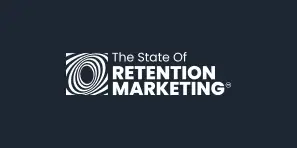
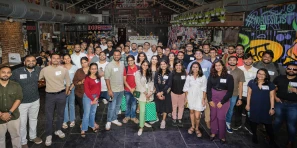
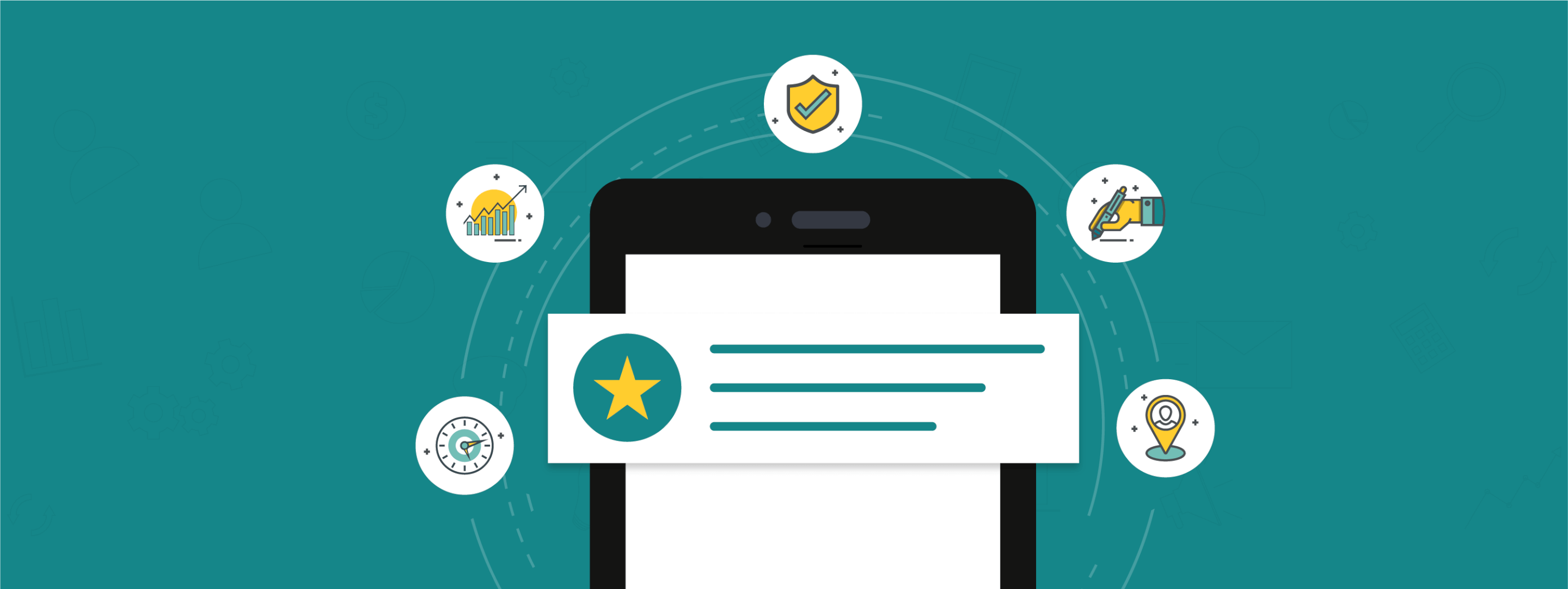

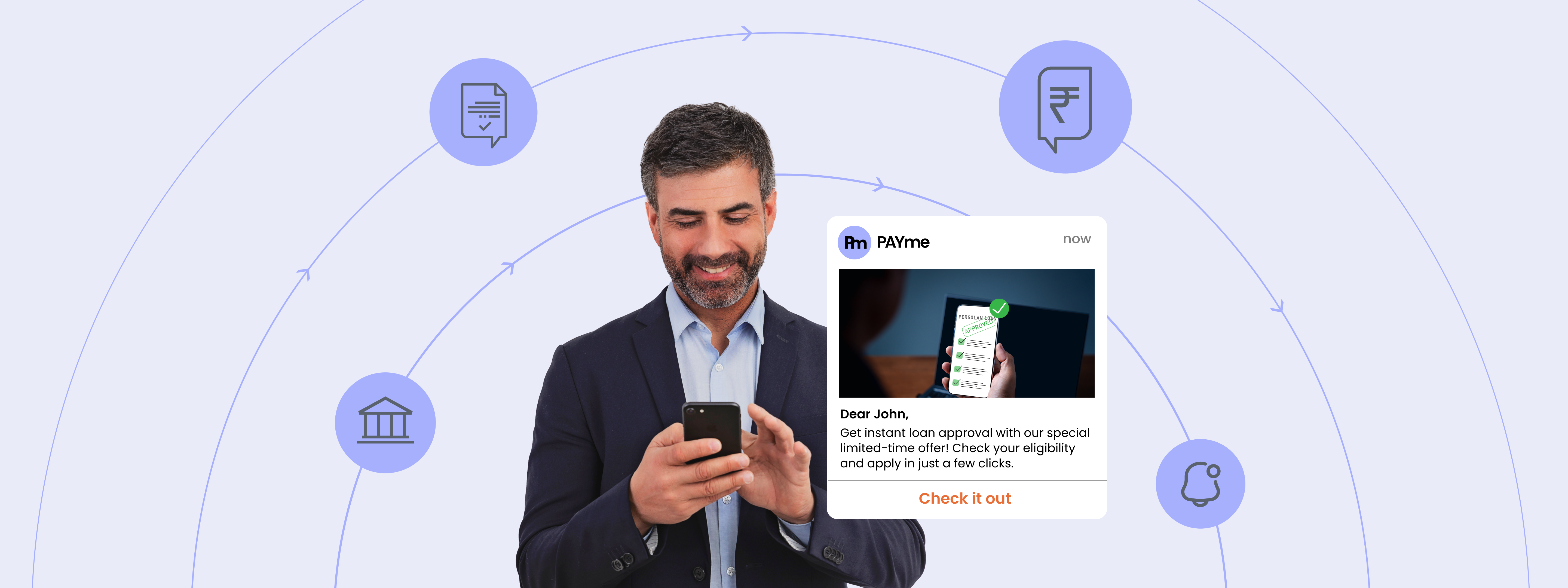
 Inioluwa Ademuwagun
Inioluwa Ademuwagun
 Diksha Dwivedi
Diksha Dwivedi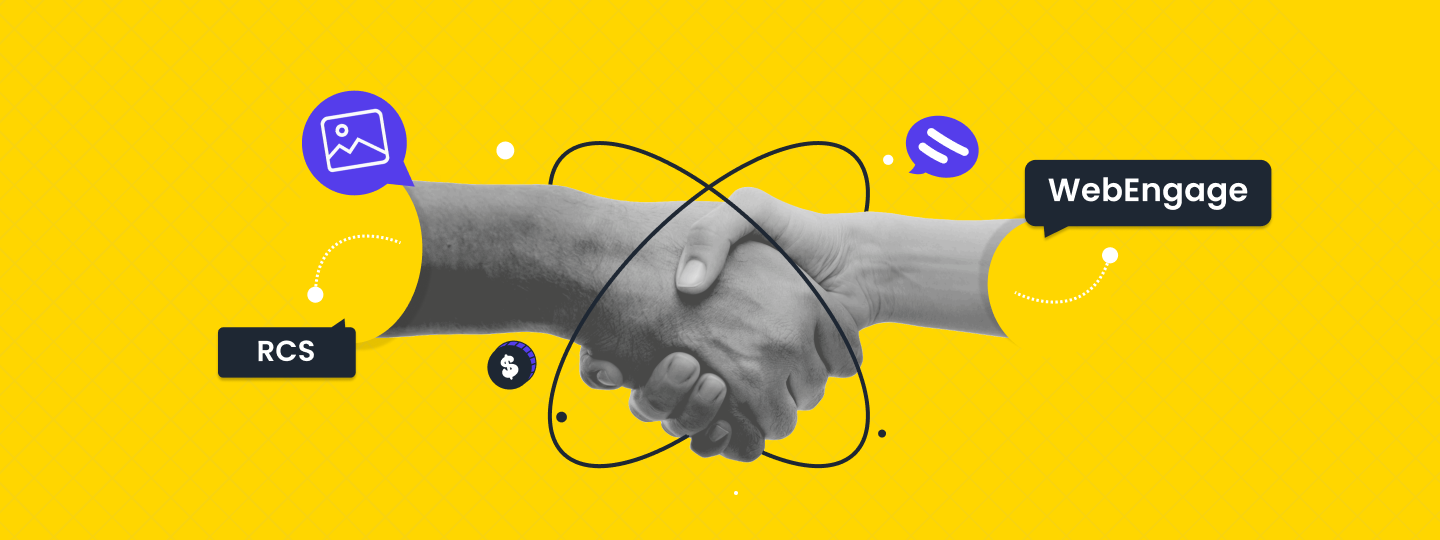
 Sanjay Mishra
Sanjay Mishra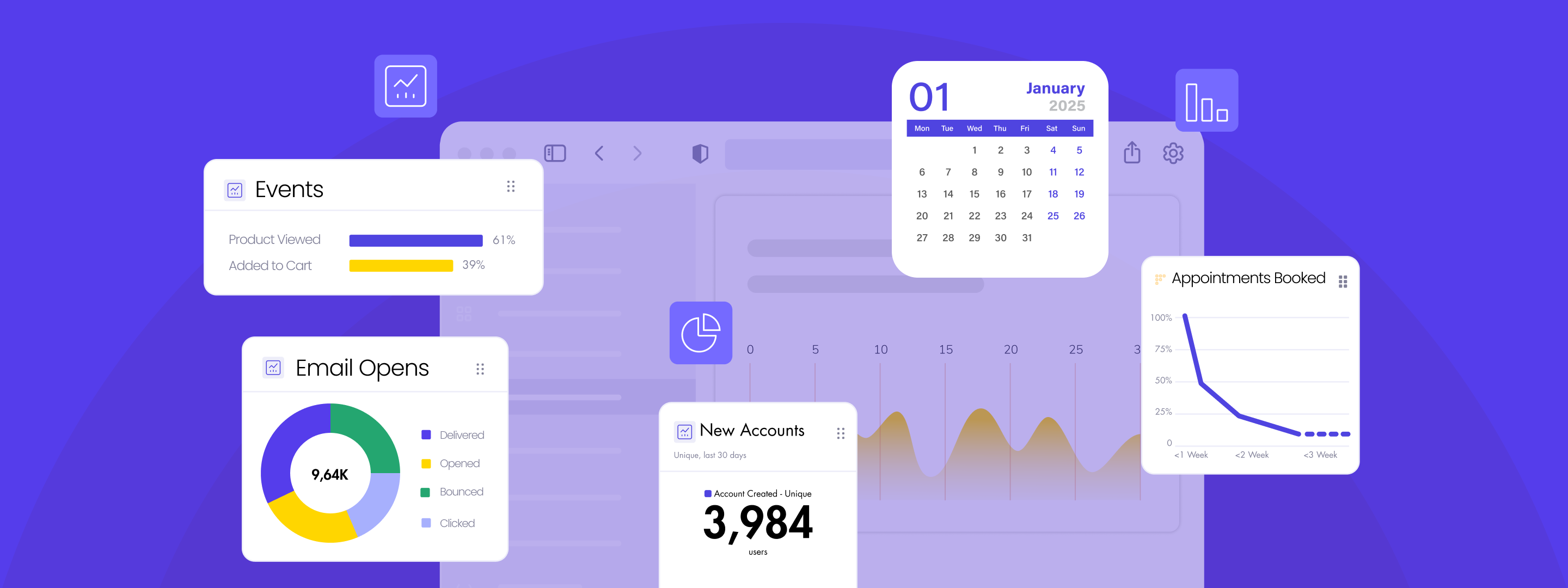
 Harshita Lal
Harshita Lal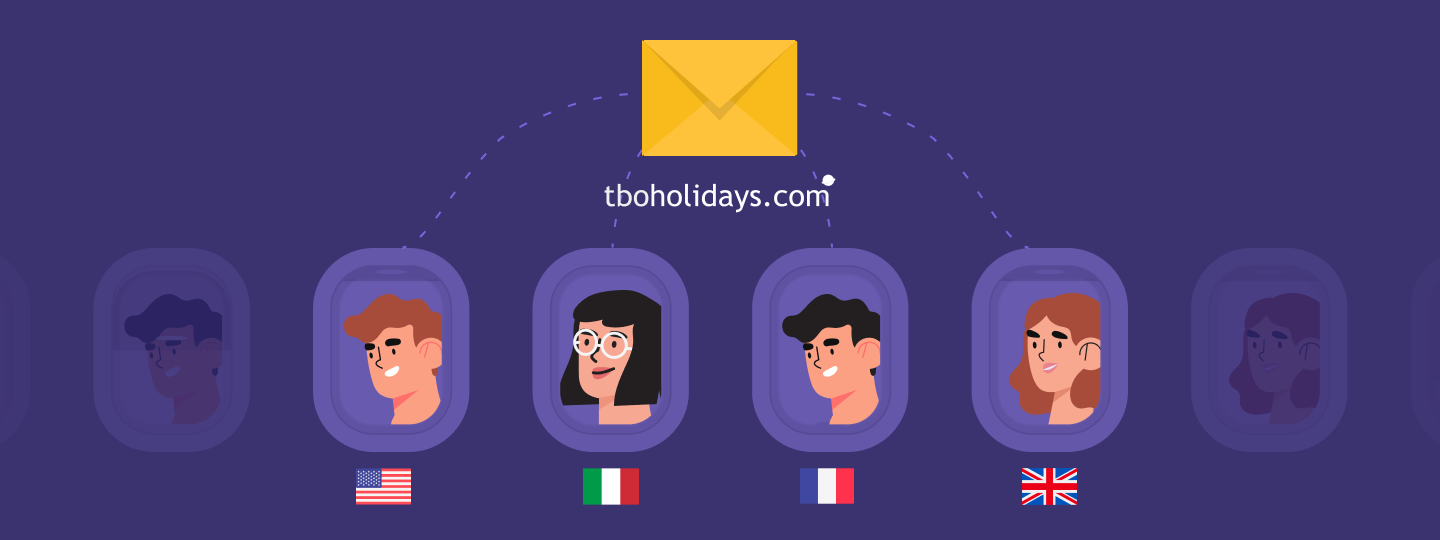
 Dev Iyer
Dev Iyer